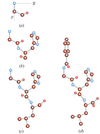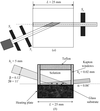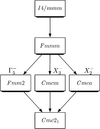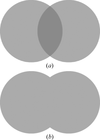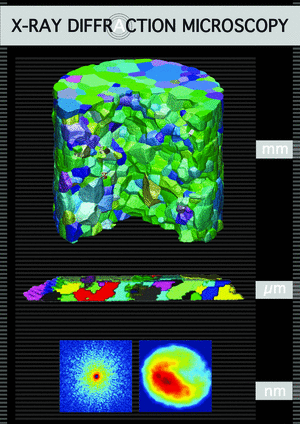issue contents
October 2009 issue

Cover illustration: Three-dimensional reconstructed crystal (purple), loop (yellow) and solvent (transparent pink) for a native DNA sample. Courtesy of Brockhauser, Di Michiel, McGeehan, McCarthy & Ravelli [J. Appl. Cryst. (2008), 41, 1057-1066].
research papers
The overall gain and point-spread function of an image-plate detector system can be determined online from single-crystal diffraction patterns to facilitate unbiased estimation of the true standard deviations of the observed integrated intensities of the Bragg reflections.
Comparison of finite element analysis with high-energy X-ray diffraction measurements demonstrates the possibility of extracting the gradation of long-range strain fields in massive high-quality single crystals like silicon from the measured Bragg intensities.
A new approach is described for indexing a powder pattern and determining the extinction group. A new figure of merit is also given.
An X-ray diffraction measurement was performed by using a TiN thin-film specimen with [111] fibre texture, in order to see whether a profile of the 420 X-ray reflection changes or not depending on the biaxial load. The results obtained by this examination agree quantitatively with a theoretical prediction.
Models of uniformity needed for defning statistical grain boundary density functions are discussed. It is proposed to use some models derived from an assumed metric of grain boundary space.
The apical ligand is bonded at the sterically more crowded side of a complex, and apical bond length shows sigmoidal dependence on distortion of the coordination polyhedron.
Cell-error effects on crystallographic data and on derived parameters are reviewed. New algorithms are presented for more efficient error handling.
The computer program PTRY has been devised to perform X-ray structural studies of crystalline peptides when only limited diffraction data are available. It is based on a random search in the internal-coordinate space and evolutionary algorithms.
An in situ synchrotron radiation grazing-incidence diffraction study is presented of the kinetics of the formation of nanoparticles of ZnO grown by the aqueous chemical growth technique.
AMPLIMODES is a computer program available on the Bilbao Crystallographic Server that can perform a symmetry-mode analysis of any distorted structure of displacive type.
This paper describes the development of efficient crystals for a Laue lens application. The theoretical study aimed to identify the crystals, either pure or two-component crystals, best suited to this application and three different materials were then characterized experimentally.
Download citation


Download citation


This paper reports neutron powder diffraction studies of ammonia dihydrate up to 2 GPa, including identification of new high-pressure polymorphs and measurement of their equations of state. Data for co-existing water ice and ammonia monohydrate polymorphs are also reported.
Extended X-ray absorption fine structure (EXAFS) data were included in simultaneously fitted experimental data for the reverse Monte Carlo refinement of local atomic structure using the public domain software RMCProfile. Structural refinements of complex perovskites demonstrated that inclusion of the EXAFS data provided the constraints necessary to recover fine details of the local atomic arrangements.
A simplified data acquisition and analysis technique, for determining the main refractive indices and the thickness of a uniaxial anisotropic crystal cut out parallel with the optical axis by digitally processing the conoscopic interference figures, is presented.
Experiments are described in which a direct comparison was made between a conventional sealed tube and a microfocus X-ray source with multilayer optics. They reveal the latter to be far superior for the investigation of small crystals.
A prototype was developed to perform online purification and automatic loading of protein solutions at a small-angle X-ray scattering beamline.
A newly developed fast mechanical X-ray chopper provides an opening time of 230 ns and an excellent long-term jitter of less than 3 ns.
An interlaboratory study on artificial and commercial Portland clinker and cements has allowed the reproducibility and uncertainty ranges for the components to be established.
Fixed-wavelength neutron and multiple-wavelength X-ray powder diffraction are used to assess phase development in alkoxide-derived titania gel as a function of temperature.
The degree of agglomeration of epoxy–TiO2 nanocomposites is elucidated by the combined use of X-ray scattering and microscopy.
An accurate numerical approach has been implemented for calculating wide-angle X-ray solution scattering patterns of proteins using the traditional scattering model that treats water as a continuum. The results suggest that, at wide angles, the excluded-volume and solvation-layer contributions to scattering cannot be reliably estimated using the continuum representation.
cryocrystallography papers
High-quality, ice-free X-ray diffraction data were continuously collected while cryoprotectant-free thaumatin crystals were cooled at 0.1 K s−1 from 300 to 100 K. This establishes the feasibility of fully temperature controlled studies of protein structure and dynamics, and provides insight into how cooling creates crystal disorder.
computer programs
An algorithm and the corresponding program SMEPOC have been developed for automatic generation of trial structures for inorganic compounds from the unit-cell content and the space-group information.
BioXTAS RAW is a fully open source software program for automated two-dimensional and one-dimensional data reduction and preliminary analysis of isotropic small-angle X-ray scattering data.
PolySNAP3 is a computer program for the classification of powder diffraction, spectroscopic and numerical data either separately or combined.
laboratory notes
Solidification of the reservoir solution with agarose allows an upside-down sitting-drop plate to be used in a hanging-drop vapor-diffusion crystallization method.


 journal menu
journal menu
















